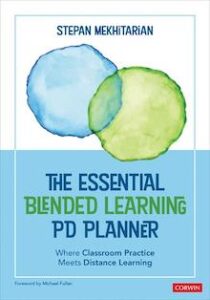PD to Take Blended Learning School Wide
The Essential Blended Learning PD Planner: Where Classroom Practice Meets Distance Learning
By Stepan Mekhitarian
(Corwin, 2021 – Learn more)
Reviewed by Chris Gall

Mekhitarian walks us through how to plan and implement the PD needed coming out of Covid closures to successfully design and utilize blended learning across the school. I wouldn’t recommend this book if you are a beginner and looking to implement a first-time blended learning program “solo” in your own classroom.

At every step along the way, he asks the reader to consider the lessons learned, technology used, and expertise in the room to ensure the successful implementation of both the PD and, ultimately, a blended learning approach.
All too often in books around PD and coaching, the teacher is treated as secondary to the process, or as if they bring zero expertise on the topic at hand. It was refreshing to see something that treated us as professionals with experiences and insights that can contribute to the process.
The limits of constructivism
While I found the book valuable, I felt that Mekhitarian’s insistence that blended learning can only be implemented in a constructivist manner was off-putting. I believe that some topics more easily lend themselves to a constructivist approach than others and have seen constructivist education poorly designed and implemented.
As a social studies teacher, constructivism is an easy approach to take; it can be genuinely engaging for kids to write their own historical narratives based on guided research, particularly if it is a topic that they already enjoy.
But when I have tutored math students (something I did as a side-gig for a number of years), I saw kids get incredibly frustrated and turned off because they could not derive the core principle that they were being asked to recreate.
While I can see where constructivism could be effective in a math classroom, I think it would (of necessity) require bypassing many topics to allow enough time for it to be done well. That does not mean that you cannot use blended learning in a math classroom, simply that the approach may not need to be constructivist in nature.
For example, you can reveal the key concept or equation to students, give them some abstract examples to work on, and then give them some real-world examples that are messier, without requiring kids to discover the underlying concept or equation from scratch.
Building and implementing year-long PD
This book provides a great example of how to design and implement year-long PD around an particular approach to education. It asks you to engage in some internal examination of your own prior experiences and practices, while also giving you the handouts and questions necessary to help you investigate as a committee what the strengths and weaknesses of the staff as a whole are – then shows how you can build on those.
Because the emphasis is on designing the PD around blended learning, and not on blended learning itself, the book is not the best choice for someone hoping to implement blended learning on a classroom level. It doesn’t contain the information you would need to do that, and the included supports (while they could be modified to suit) are not really built around that idea. Additionally, Mekhitarian does not include any explicit information on specific technologies that might be helpful, leaving that to the building-level staff and administration to determine.
I would strongly recommend The Essential Blended Learning PD Planner to building level administrators who are hoping to build an inclusive PD model into their program (whether that is around blended learning or not), simply because it is a wonderful primer around which to start to think of how to incorporate teachers and other stakeholders into the PD planning process.
Chris Gall is a middle school teacher at Internet Academy in Federal Way, Washington. This position requires that she design and implement classes that can be done completely asynchronously and self-paced for all students, including those with special needs. Chris has also been a technology implementation coach for 8 years, department chair at multiple levels for 3 years, and has taught students of all abilities in grades 6-12.




























